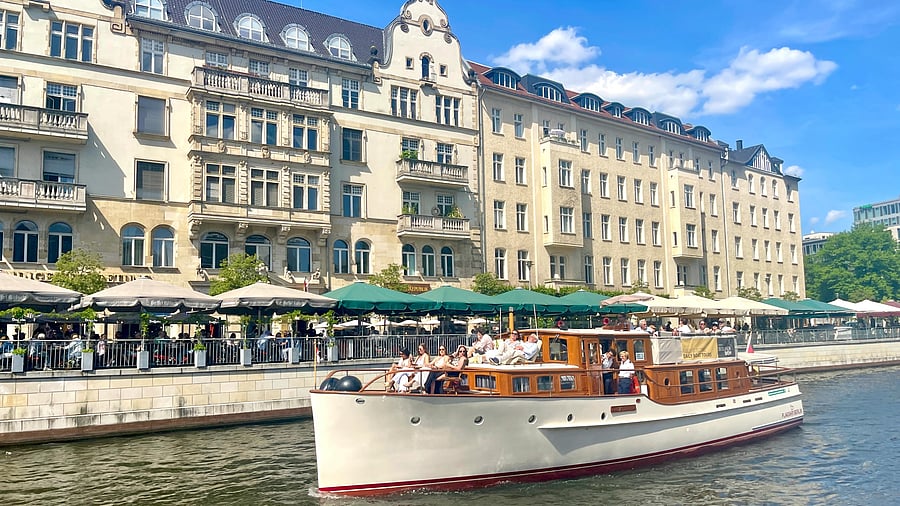
In Berlin, the past is never far away. Not surprising really, since the past – especially the last century – has not been very kind to this glorious city. Whether it is the Holocaust that divided the people into us and them, or the infamous Wall that continued on the same theme under a different name, Berlin is still coming to terms with the many injustices it has been a silent witness to.
When I step out of my hotel at Potsdamer Platz on a bright morning, I know I am going on a walk to peek into this very past. For, my guide Tatjana Rossa herself grew up in East Germany, with her parents who were deeply committed to the socialist cause in the GDR, or German Democratic Republic, as East Germany was then called. This year marks the 35th anniversary of the Reunification, eleven months after the fall of the Berlin Wall, and I am keen to know more about the sociopolitical fault lines that caused the split in the first place, and any physical remains that still exist. The latter – it’s easy. Just a ten-minute walk from the Lulu Guldsmeden hotel leads us to Potsdamer Platz, the prime example of Berlin’s reinvention after the fall of the wall.
Sights of the city
On the way, I cross the Neue Nationalgalerie (the new National Gallery), where I make a quick detour to take in the temporary exhibition on Yoko Ono’s work around the theme of peace, titled ‘Dream Together.’ Fitting for Berlin, I think, as I walk around the framed collection of simple but powerful newspaper ads Ono and Lennon had taken out in the 1960s to protest the Vietnam War.
Further along the way, I stop to admire the splendid glass dome of the landmark building known as Center Potsdamer Platz (until a couple of years ago, called Sony Center), where kids are playing around the central fountains and officegoers in formal suits are grabbing a quick mid-morning coffee. Then there is the Boulevard of the Stars, which marks 120 years of the German film industry, commemorating its biggest actors and directors with a star, complete with its own red carpet.
From where I’m standing, I am surrounded by gleaming skyscrapers and tony cafés all around. And it is difficult to imagine that not too long ago, this was a desolate no-man’s land. Under my feet, I can feel a row of cobblestones marking the path of the wall, and up ahead, a showcase of photographs and information about its history, with small sections of the original bullet-marked wall preserved for posterity.
Then there are those who lived through it all, and still carry the scars from those times. The exhibits tell a heartbreaking story of families getting sundered and lives getting shattered overnight. I have tears in my eyes as I read about a mother being shot after trying to escape with her child. When I look up, I see a similar emotion on Tatjana’s face. “It doesn’t get any easier after all these years,” she says.
There is another remaining length of the wall along the Spree River, but this has transformed into a symbol of peace. This 1.3-km stretch of wall murals and authorised graffiti, known as the East Side Gallery, has provided much-needed space for artists from all over the world to express their discontent against fascism and war.
Remembrance of things past
Among the many stunning murals is the famous “Fraternal Kiss” by artist Dmitri Vrubel, which depicts Brezhnev and Honecker (the former leaders of the Soviet Union and the German Democratic Republic respectively) locked in a socialist embrace. Cheekily titled ‘My God, Help Me to Survive this Deadly Love’, this mural is as playful as it is provocative and rebellious – a tone reflected in most of the artworks on this slice of the wall. And then is the graffiti scrawled by
countless other hopefuls all over, expressed as cries against petty divisiveness and calls for unity.
Horrors of the Holocaust
There is another kind of remembrance that the Holocaust Memorial – also called the Memorial to the Murdered Jews of Europe – forces upon visitors. Located close to the iconic Brandenburg Gate with its grandiose statues up top, this memorial is a striking contrast with its straight rows of 2710 grey, squat blocks. The starkness is intentional, says Tatjana. But I still wonder about the difference in their heights. It is only when I walk in the narrow space between the columns that I understand the significance: it becomes disorienting and daunting so quickly that I get a fleeting idea of the desperation felt by those trapped by the Holocaust. I can get out when I want, but thousands had no escape.
All this is not to suggest that Berlin is one big gloomy mess. On the contrary, the warm day has brought locals out in full force, walking, drinking and dancing in the numerous parks and plazas scattered across the city. I get a glimpse of this on an afternoon boat ride on the Spree and at Tiergarten Park later in the evening. And at the Berlin Global exhibition at the newly opened Humboldt Forum museum complex, I get a better sense of the city’s youthful, urban vibe and its place in the larger world. And I also get a sense that Berlin is not forgetting its past, but also not allowing it to shape the future.